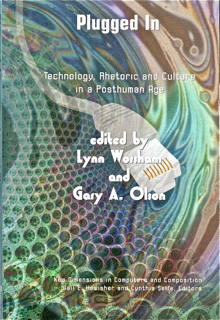Plugged In: Technology, Rhetoric and Culture in a Posthuman Age Edited by Lynn Worsham and Gary A. Olson (2008)
Conclusion: Theoria and Ecologies
"The ten essays in this book are substantive contributions to the ever-growing scholarly conversations about the role of technology in our professional and personal lives. We hope you find them as stimulating and provocative as we do." ~Lynn Worsham and Gary A. Olson |
|---|
Johnson's argument in the final essay of this outstanding collection that networks have a proverbial life of their own shares much affinity with recent work on theories of technology and existence. As Worsham and Olson’s collection indicates, technological milieu and co-adaptive networks possess a posthuman 'efficient' and 'final' cause (what Johnson calls Google). Living beings are left trying to detect their faint platonic shadow as users always already inscribed as Other by the dynamics of technology. As the other theorists in the cyber-gloss that accompanies the margins of this review additionally attest, the overdetermined relationships among networks, bodies, and technological-beings-and-becomings present a difficult terrain of assessment for theory, pedagogy, and cyber practices. Worsham and Olson's assemblage of thinkers urges readers to accept that an engagement with interfaces is inevitable regardless of any given discipline's strategic distancing.
This collection articulates the need to theorize and embody an identity paradoxically beyond the subjects and objects that populate theories of Enlightenment and selfhood. These authors also testify to a need to re-think mechanistic views of technology as a neutral instrument with an essence reducible to users' designs. The contributors productively trace the points of intersection between networks and bodies that will better equip living beings for their seemingly inevitable need to communicate with networked others — both living end users and technological interfaces — that they encounter in these interfacial spaces.
Haraway, Donna. (1990). A manifesto for cyborgs: Science, technology, and socialist feminism in the 1980’s. In Linda J. Nicholson (Ed.), Feminism/Posthumanism (pp. 190-233). New York: Routledge.
Hayles, N. Katherine. (1999). How we became posthuman: Virtual bodies in cybernetics, literature, and informatics. Chicago: University of Chicago Press.
Haynes, Cynthia. (1995, March). Loss, prosthetics, and the rhetoric of technology. Presentation at Conference on College Composition and Communication, Washington, DC.
Heidegger, Martin. (2008). The question concerning technology. In David Farrell Krell (Ed.), Basic writings: Key selections from Being and Time to The Task of Thinking (pp. 307-42). New York: Harper Collins.
Massumi, Brian. (2002). Parables for the virtual: Movement, affect, sensation. Durham, NC: Duke University Press.
Plato. (1961). Definitions. In Edith Hamilton and Hungton Cairns (Eds.), The collected dialogues. Princeton, NJ: Princeton University Press.
Ronell, Avital. (2004). Crack wars: Literature and addiction mania. Lincoln, NE: University of Nebraska Press.
Stiegler, Bernard. (1998). Technis and time: The fault of epimetheus. Palo Alto, CA: Stanford University Press.
Taylor, Mark. (2001). The moment of complexity: Emerging network culture. Chicago: University of Chicago Press.

